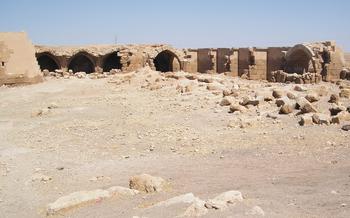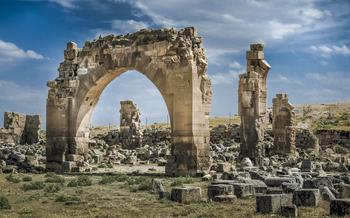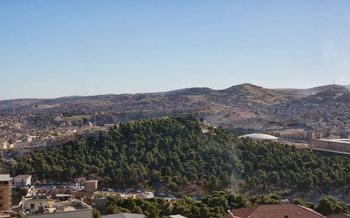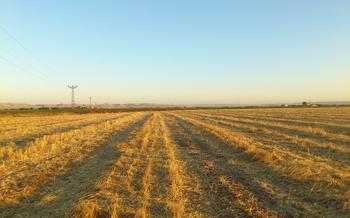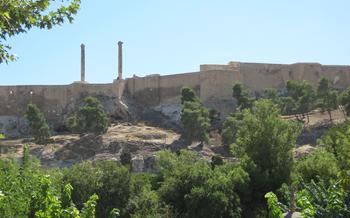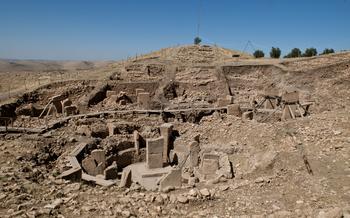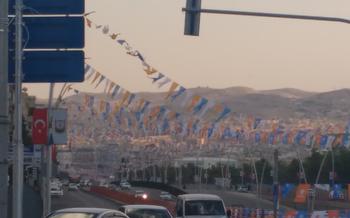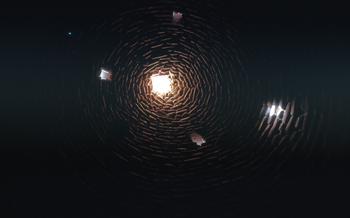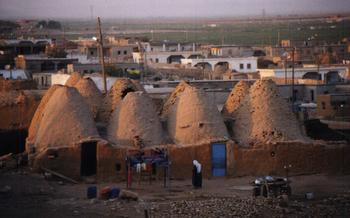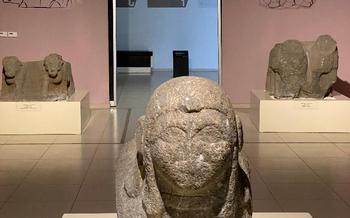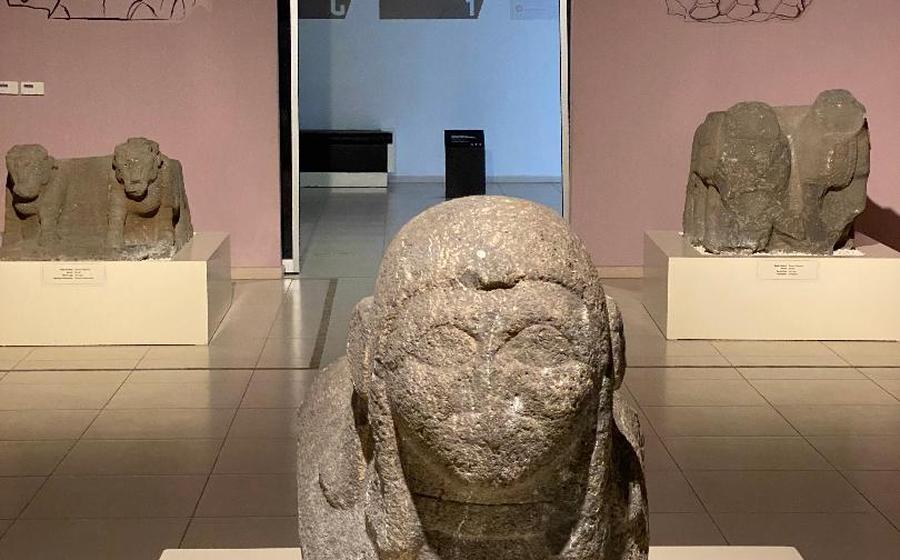
Urfa Archaeology Museum (Şanlıurfa Müzesi)
- Delve into the Past:
- Journey Through Civilizations
- Must-See Highlights
- Unveiling Göbekli Tepe: The World's Oldest Temple
- Zeugma Mosaics: A Masterpiece
- Balıklıgöl: A Sacred Site
- Harran Beehive Houses: Unique Architecture
- Getting There
- Museum Hours and Admission
- Exploring the Museum
- Planning Your Visit
- Cultural Insights and Etiquette
- Family-Friendly Activities
- Accessibility for All
- Insider Tip:
Delve into the Past:
The Urfa Archaeology Museum (Şanlıurfa Müzesi) stands as a testament to the rich archaeological heritage of Şanlıurfa, inviting you on a journey through time. Established in 1969, the museum has undergone several expansions and renovations, evolving into a modern and comprehensive institution. Its primary focus lies in preserving and showcasing the invaluable artifacts unearthed from the region, including the world-renowned site of Göbekli Tepe.
Among its treasures, the museum houses an impressive collection of Neolithic artifacts, including the world's oldest known human-made structures, dating back to around 10,000 BC. These remarkable discoveries from Göbekli Tepe have revolutionized our understanding of human history and shed light on the origins of civilization. Moreover, the museum boasts an extensive collection of sculptures, mosaics, and inscriptions, spanning various civilizations that have left their mark on the region. From the grandeur of the Hittites to the influence of the Assyrians and Romans, the museum offers a glimpse into the diverse cultural tapestry that has shaped Şanlıurfa's past.
Journey Through Civilizations
The Urfa Archaeology Museum invites you on a journey through civilizations, showcasing the rich tapestry of cultures that have shaped the region. Explore the legacy of ancient civilizations such as the Hittites, Assyrians, and Romans, each leaving their unique mark on the region's history and heritage. Discover the harmonious blend of cultures and influences that have influenced the region's art, architecture, and traditions. Witness the exquisite craftsmanship of ancient mosaics and statues, telling stories of bygone eras and providing a glimpse into the lives of those who came before us. Engage with interactive displays and multimedia presentations that bring history to life, offering a multidimensional experience that transports you back in time.
Must-See Highlights
The Urfa Archaeology Museum is home to a treasure trove of artifacts that span various periods of history. Among the must-see highlights are the Neolithic artifacts, which represent the world's oldest known human-made structures. These artifacts, dating back to around 9000 BC, provide a glimpse into the earliest civilizations and their remarkable achievements.
Another highlight of the museum is the collection of Zeugma mosaics, which are considered masterpieces of ancient art. Excavated from the ancient city of Zeugma, these intricate mosaics depict scenes from Greek mythology, daily life, and religious beliefs. The vibrant colors and detailed craftsmanship of these mosaics offer a vivid portrayal of life in the ancient world.
Finally, a visit to the sacred pool of Balıklıgöl, located just a short walk from the museum, is a must. This sacred site is believed to have healing powers, and its legendary carp are a symbol of the city's rich cultural heritage. Visitors can feed the carp and marvel at the tranquil atmosphere of this holy place.
Unveiling Göbekli Tepe: The World's Oldest Temple
Göbekli Tepe, a prehistoric site located just 12 kilometers from Şanlıurfa, holds the distinction of being the world's oldest known temple, predating Stonehenge by around 6,000 years. Its discovery in the 1990s sent shockwaves through the archaeological community, challenging long-held beliefs about the origins of civilization.
The site consists of a series of circular enclosures formed by massive T-shaped pillars, some of which stand over 5 meters tall. These pillars are adorned with intricate carvings of animals, humans, and abstract symbols, adding to the mystery and intrigue of the site.
The purpose of Göbekli Tepe remains a subject of debate among archaeologists. Some believe it was a ceremonial center, while others suggest it may have been used for astronomical observations or as a meeting place for trade and social gatherings. Ongoing excavations and research at the site continue to shed light on its significance and role in ancient history.
A visit to the Göbekli Tepe Museum in Şanlıurfa offers a chance to learn more about this remarkable site. The museum displays artifacts found during the excavations, including the iconic T-shaped pillars, as well as scale models and interactive exhibits that bring the ancient world to life.
A trip to Göbekli Tepe is a journey into the distant past, a chance to explore the origins of human civilization and marvel at the ingenuity and creativity of our ancestors.
Zeugma Mosaics: A Masterpiece
Zeugma, an ancient city once situated on the banks of the Euphrates River, has gifted the world with an extraordinary collection of mosaics that now reside in the Şanlıurfa Müzesi. These breathtaking artworks, meticulously crafted by skilled artisans, offer a captivating glimpse into the lives, beliefs, and artistic prowess of the Zeugma inhabitants.
Excavated from the ruins of the ancient city, the Zeugma Mosaics have been painstakingly preserved and restored, allowing visitors to marvel at their intricate details and vibrant colors. Among the highlights of the collection are the stunning depictions of scenes from Greek mythology, including the epic Labors of Hercules and the legendary Trojan War.
Beyond mythological tales, the mosaics also provide a fascinating window into the daily lives of the Zeugma people. They portray scenes of everyday activities, such as hunting, fishing, and attending banquets, offering a tangible connection to the past.
The Zeugma Mosaics stand as a testament to the artistry and cultural richness of this ancient civilization. Whether you're a history buff, an art enthusiast, or simply someone who appreciates beauty, these masterpieces are not to be missed.
Balıklıgöl: A Sacred Site
Balıklıgöl, or the "Fish Lake," is a sacred site located in the heart of Şanlıurfa. According to local legend, the prophet Abraham was thrown into a fire by King Nimrod for refusing to worship idols. However, God turned the fire into a pool of water and the burning logs into fish, saving Abraham's life. The carp in the lake are believed to be descendants of those miraculous fish, and they are considered to have healing powers.
Visitors to Balıklıgöl can feed the carp and make a wish. They can also visit the nearby mosque and shrine, which are dedicated to Abraham. The site is a popular pilgrimage destination for Muslims and Christians alike, and it is a place of great spiritual significance.
In addition to its religious significance, Balıklıgöl is also a beautiful and peaceful place. The lake is surrounded by lush gardens and trees, and the sound of the water and the birdsong creates a serene atmosphere. Visitors can relax and enjoy the tranquility of the site, or they can explore the nearby shops and restaurants.
Insider Tip:
- Visit Balıklıgöl early in the morning or late in the evening to avoid the crowds.
- Be respectful of the religious significance of the site and dress modestly.
- Don't forget to make a wish when you feed the carp!
Harran Beehive Houses: Unique Architecture
In the village of Harran, just a short drive from Şanlıurfa, visitors can marvel at the unique architecture of the beehive-shaped houses. These intriguing structures, built entirely of mud bricks, have fascinated travelers and archaeologists alike for centuries.
The history of these houses can be traced back to ancient times when people in the region sought shelter from the harsh desert climate. The domed shape of the houses provides insulation, keeping them cool in the summer and warm in the winter. The thick walls also offer protection from sandstorms and other extreme weather conditions.
The construction techniques used to create these resilient structures are truly remarkable. The mud bricks are carefully stacked in a spiral pattern, without the use of any mortar. The domed shape is achieved by gradually reducing the diameter of the bricks as the structure rises. The result is a sturdy and durable dwelling that has stood the test of time.
Beyond their practical function, the beehive houses also hold cultural significance. They represent the ingenuity and adaptability of the local people, who have utilized the available resources to create a unique and sustainable way of life. Today, these houses serve as a reminder of the region's rich architectural heritage and continue to be a source of pride for the local community.
Getting There
Şanlıurfa is conveniently located in southeastern Turkey, offering easy access from major cities and transportation hubs. The city can be reached by air through Şanlıurfa Airport (GNY), which has direct flights from Istanbul, Ankara, and other domestic destinations.
Bus services are a popular and affordable option, with regular connections from neighboring cities and towns. The main bus terminal is situated near the city center, providing easy access to local transportation.
For those seeking a scenic journey, trains offer a unique way to experience the region's landscapes. The Şanlıurfa railway station connects the city to major destinations, including Istanbul, Ankara, and Diyarbakır.
Guided tours are an excellent choice for a hassle-free and informative experience. These tours often include visits to the Urfa Archaeology Museum along with other prominent attractions in the region. Local travel agencies and hotels can provide recommendations for reputable tour operators.
Museum Hours and Admission
Plan your visit to the Şanlıurfa Müzesi by checking its operating hours to avoid any inconvenience. The museum generally follows a consistent schedule, but it's advisable to consult its official website or local tourism resources for any seasonal variations or special closures.
Admission to the museum requires an entrance fee, which is typically quite reasonable and often includes access to all galleries and exhibits. However, there may be additional charges for specific guided tours or special events. Discounts or concessions are often available for students, seniors, and families, so be sure to inquire about these when purchasing your tickets.
Consider exploring the option of purchasing tickets online, especially during peak tourist seasons. This can save you time and allow you to skip any queues at the ticket counter. Online ticketing platforms often provide real-time availability and allow you to choose a preferred time slot for your visit.
Exploring the Museum
The Urfa Archaeology Museum is a treasure trove of historical artifacts, and navigating its vast collection can be an enriching experience. Begin your journey by understanding the museum's layout, which is divided into several galleries, each showcasing specific themes or periods of history. Identify the must-see exhibits and highlights in each gallery, ensuring you don't miss the most significant artifacts. To enhance your exploration, consider renting an audio guide or downloading the museum's app, providing detailed information and insights into the exhibits. Remember to be mindful of any photography restrictions or guidelines within the museum to preserve the integrity of the artifacts for future generations.
Planning Your Visit
Best Time to Visit:
Şanlıurfa experiences hot summers and cold winters. The best time to visit the Urfa Archaeology Museum and explore the city's attractions is during spring (April-May) or autumn (September-October) when the weather is pleasant. Summer months (June-August) can be scorching, while winters (November-March) can be chilly and wet.
Duration of Visit:
Allocate at least two hours to explore the Urfa Archaeology Museum thoroughly. Take your time to admire the exhibits, read the descriptions, and immerse yourself in the history and culture of the region. If you're particularly interested in archaeology or history, you may want to spend even more time exploring the museum's vast collection.
Combining Attractions:
Combine your visit to the Urfa Archaeology Museum with other nearby attractions to make the most of your trip to Şanlıurfa. Göbekli Tepe, located just 12 kilometers northeast of the city, is a must-see for history buffs. The ancient city of Harran, with its unique beehive-shaped houses, is another popular destination. Şanlıurfa Castle, with its impressive fortifications and panoramic views, is also worth a visit.
Local Cuisine:
Şanlıurfa is renowned for its rich culinary traditions. Take the opportunity to sample local dishes such as çiğ köfte (raw meatballs), lahmacun (Turkish pizza), and kebabs. Indulge in the city's famous desserts, including künefe (shredded wheat pastry soaked in syrup) and şıllık (a sweet pastry filled with nuts).
Cultural Insights and Etiquette
When embarking on a journey to Şanlıurfa, it's essential to be mindful of local customs and etiquette to ensure a respectful and enjoyable visit. Familiarize yourself with the Turkish culture before your trip to avoid any misunderstandings or faux pas. Dress modestly, especially when visiting religious sites or conservative areas, and be mindful of your body language and gestures. Learn basic Turkish phrases, such as greetings and thank you, to show respect and connect with locals. Remember that Turkey is a predominantly Muslim country, so being respectful of religious beliefs and practices is of utmost importance. Embrace the opportunity to interact with locals, but be mindful of personal space and avoid overly intrusive questions. By understanding and respecting local traditions, you'll contribute to a positive cultural exchange and make your visit to Şanlıurfa a truly enriching experience.
Family-Friendly Activities
The Urfa Archaeology Museum provides an engaging and educational experience for families with children. Interactive exhibits and educational programs bring history to life, making learning fun and accessible for young minds. Storytelling sessions and workshops captivate children's imaginations, allowing them to connect with the past in a meaningful way. Family-friendly guided tours are available, tailored to the interests and attention spans of children, ensuring a memorable and enriching experience for the whole family. On-site cafes or designated picnic areas offer opportunities for families to relax and refuel while enjoying their time at the museum.
Accessibility for All
The Urfa Archaeology Museum is committed to creating an inclusive and welcoming environment for all visitors, regardless of their abilities or disabilities. The museum offers a range of accessibility features to ensure that everyone can enjoy and learn from its exhibits.
Wheelchair users and visitors with limited mobility will find ramps and elevators throughout the museum, making it easy to navigate the different galleries. Assisted tours and specialized services are also available for visitors with disabilities, upon request.
For visitors with visual or hearing impairments, the museum offers sensory exhibits and programs that cater to their specific needs. Descriptive audio guides and tactile exhibits allow blind and visually impaired visitors to experience the artifacts and learn about their history.
The Urfa Archaeology Museum is a place where everyone is welcome and encouraged to explore the rich cultural heritage of Şanlıurfa. The museum's commitment to accessibility ensures that all visitors can have a meaningful and enriching experience.
Insider Tip:
Uncover the hidden treasures of the Şanlıurfa Müzesi by exploring lesser-known exhibits that often go unnoticed by the crowds. Seek out the enigmatic artifacts that tell unique stories about the region's rich history. Engage the services of knowledgeable local guides who can provide personalized insights and anecdotes, bringing the museum's collection to life. Escape the tourist throngs by visiting during the shoulder or off-season, allowing you to savor a more serene and immersive museum experience. Finally, align your visit with local festivals or events to immerse yourself in the vibrant cultural tapestry of Şanlıurfa, creating a truly memorable and enriching journey.
